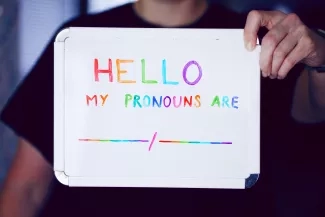Why It Matters

Photo by Sharon McCutcheon | Unsplash
“My doctor tried, but she didn’t really understand what the big deal was.”
Sid (not their real name) is a nonbinary parent who gave birth to their two children 16 months apart. Sid is recounting the emotional pain of never having their care team acknowledge their gender identity.
Despite being at a practice that Sid described as “a very progressive space” through both of their pregnancies, no one would refence Sid’s gender correctly. “That really, really wore me down,” Sid remembered. “I was experiencing such intense gender dysphoria.” Gender dysphoria is clinically significant distress caused by a misalignment of gender identity and sex assigned at birth. For some nonbinary persons, being referred to as a woman or with the wrong pronouns causes them to experience gender dysphoria. For Sid, this made coping with the severe post-partum anxiety they had after their first child especially difficult. “Constantly having people deny my gender identity and who I am as a person made me too tired to advocate for myself. It made me feel like I wasn’t worth the care.”
What could Sid’s health care providers have done to avoid harm and better care for Sid’s psychological safety?
For people of all genders, affirming care plays a key role in health outcomes. For example, in their study “Transgender men and pregnancy,” Juno Obedin-Maliver and Harvey J. Makadon write, “What becomes clear from qualitative study and more generalized experience caring for transgender people is that a positive psychological outcome will depend on the experience someone has from the moment they first present for care and depends on the total experience from beginning to end being inclusive and affirmative.” They add, “Understanding all individuals’ gender identity will support comprehensive health services.”
One important way to be inclusive of people of all gender identities is to use gender-affirming language. At the Institute for Healthcare Improvement (IHI), to recognize that not everyone who gives birth identifies as a woman, the Better Maternal Outcomes team made the decision to shift its language from “women” to “birthing people” or “people who give birth” to include cisgender women, transgender men, and nonbinary people. The Better Maternal Outcomes Rapid Improvement Network was a three-year (April 2018 to October 2021), large-scale project to improve outcomes for all people who birth in the United States and their babies, and to reduce the stark inequities in maternal health. It was funded with generous support from Merck for Mothers. “When we do this work,” said IHI Senior Project Director Shannon Welch, “it’s important that everyone can see themselves in it.”
IHI Senior Director Kelly McCutcheon Adams recognizes that this change in language can be a challenging adjustment and sometimes contentious. “When we shift from words like maternal, women, or mother, there’s sometimes a fear that we may lose track of the ways sexism asserts itself in the world and how women experience life,” she acknowledged. “There is complexity around issues of sexism,” she continued, “And [this evolution in language] reflects this complexity.” She sees respecting an individual’s gender identity and using gender-affirming language as “open-minded and open-hearted.” Welch added, “Some women ask, ‘What about me?’ We ask them to reframe the question to, ‘What about us?’ We want everyone to feel welcome and included.”
Some health care professionals who now fully support using gender-affirming language admit making the change was not initially easy. One track of the Better Maternal Outcomes initiative was called Redesigning Systems with Black Women. Participants worked to improve equity, dignity, and safety while reducing racial inequities in maternal outcomes for Black people who birth. Audrey Stewart, a midwife and an owner of the Birthmark Doula Collective (New Orleans, Louisiana), was a Redesigning Systems with Black Women faculty member. Stewart noted that, “A lot of the conversations about birth outcomes, particularly severe mortality, center in misogyny, or [seem as if] only the baby’s life matters.” Because Birthmark Doula Collective has spent years “trying to wave a flag [saying] women’s experience matters,” Stewart explained, they wrestled with switching from saying “women” to “birthing people.”
Stewart’s organization came to appreciate, though, the benefits of using inclusive language. “Sometimes you don’t know who you’re leaving out until you begin not leaving folks out,” she observed. “And then you suddenly realize that there were a lot of people being left out.” She added, “We know that when you prioritize inclusion for one group of people, it nearly always improves the experience of everybody. Everyone benefits from a reexamination of gender binaries and a deeper and more liberating approach to gender.”
“It’s amazing,” said Sid when asked what it’s like when their health care providers use language that respects their gender identity. “I feel comfortable telling them the truth. I feel safe enough to talk to them. There’s something about the way my current provider actually bothers to see the whole person that [makes me] feel safe saying things to her that I wouldn’t have said to previous providers. I knew she’d actually listen to me.”
Sid added, “Using more inclusive language won’t harm your average person who identifies as a mother, but it will mean absolutely everything to someone like me.”
Rachel Hock is an Institute for Healthcare Improvement Senior Executive Assistant.
